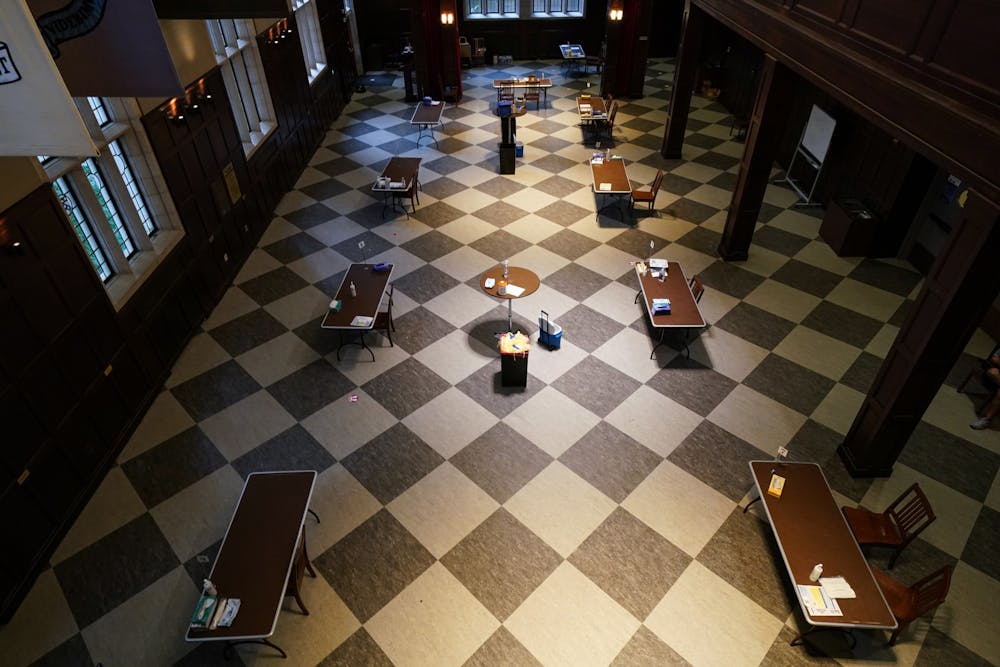
Out of the 107 people who tested positive at the Houston Hall testing site last week, 90 were undergraduate students.
Credit: Chase SuttonIn conjunction with a drop in temperature at the tail end of October, Penn recorded this semester's highest weekly count of positive COVID-19 cases last week at 107 cases.
For just the second time this semester, the positivity rate climbed above 2%, reported at 2.2%. Out of the 107 new cases, 90 were undergraduate students with only 17 new cases reported among graduate students, faculty, staff, and other Penn affiliates. Undergraduate students also represented the highest positivity rate at 3.3% last week in comparison to the other communities.
These statistics reflect students’ reports of longer lines for both symptomatic and asymptomatic individuals at Houston Hall’s COVID-19 testing site last week.
When students arrive at the testing site, asymptomatic students with a Green PennOpen Pass are prompted to stand in a line that runs along Spruce Street and is covered by a series of white tents. Those who have a Red PennOpen Pass, indicating that they are symptomatic or may have come into contact with someone with symptoms, must stand in a separate line alongside Houston Hall's Hall of Flags.
While a COVID-19 test is scheduled to take a maximum of 10 minutes according to the appointment scheduling program, some students like College sophomore Zoë Affron reported waiting in line for upwards of an hour.
Affron, who gets tested once a week, said the Green PennOpen Pass line last Tuesday around noon was longer than she had ever seen it before, extending from Houston Hall to Irvine Auditorium and turning the corner on 34th Street. She estimated the line to be about 50 people long, adding that there were also three students in the Red PennOpen Pass line.
For College sophomore George DeVries, who went to Houston Hall around 1:20 p.m. the same day, the 20-minute wait in the Green PennOpen Pass line was much longer than he had ever experienced before. DeVries added he also saw students in the symptomatic line for the first time this semester.
Chief Operating Officer for Wellness Services Erika Gross told The Daily Pennsylvanian in an Oct. 27 interview that the longer wait time during the middle of the day is normal, citing a lunchtime rush from undergraduate and graduate students, faculty, and staff alike.
"We continue to see that students want to be tested," Gross said. "We continue to remind them, however, that testing is only one part of the public health strategy to keep the Penn and greater Philadelphia community safe."
Gross added that a negative test result does not mean students can stop following health precautions like wearing masks, practicing social distancing, and washing their hands, and she urged students to stay vigilant to prevent the spread of COVID-19.
Pennsylvania reported its largest single-day increase in COVID-19 cases with 2,875 new cases on Tuesday. Health experts warn of another wave of COVID-19 cases in the winter months, as people prefer to spend their time indoors.
Gross said Penn's COVID-19 testing has remained robust throughout the year, citing a daily average of 700 to 800 people getting tested each day during the third week of October.
Penn's COVID-19 testing site is open Monday through Saturday and has averaged anywhere from 600 to over 800 tests a day in October. Last month, Penn began reporting COVID-19 data for the undergraduate, graduate, and faculty and staff demographics to supplement the cumulative numbers of the Penn community.
The Daily Pennsylvanian is an independent, student-run newspaper. Please consider making a donation to support the coverage that shapes the University. Your generosity ensures a future of strong journalism at Penn.
Donate







